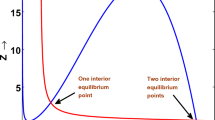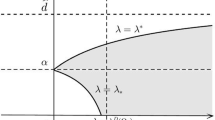Abstract
A reaction–diffusion–advection predator–prey model with Holling type-II predator functional response is considered. We show the stability/instability of the positive steady state and the existence of a Hopf bifurcation when the diffusion and advection rates are large. Moreover, we show that advection rate can affect not only the occurrence of Hopf bifurcations but also the values of Hopf bifurcations.

Similar content being viewed by others
Data availability statement
All data generated or analyzed during this study are included in this manuscript.
References
Averill, I., Lam, K.-Y., Lou, Y.: The role of advection in a two-species competition model: a bifurcation approach. Mem. Am. Math. Soc. 245(1161), v+117 (2017)
Belgacem, F., Cosner, C.: The effects of dispersal along environmental gradients on the dynamics of populations in heterogeneous environments. Can. Appl. Math. Q. 3(4), 379–397 (1995)
Cantrell, R.S., Cosner, C., Lou, Y.: Movement toward better environments and the evolution of rapid diffusion. Math. Biosci. 204(2), 199–214 (2006)
Cantrell, R.S., Cosner, C., Lou, Y.: Advection-mediated coexistence of competing species. Proc. R. Soc. Edinb. Sect. A 137(3), 497–518 (2007)
Chen, X., Lou, Y.: Principal eigenvalue and eigenfunctions of an elliptic operator with large advection and its application to a competition model. Indiana Univ. Math. J. 57(2), 627–658 (2008)
Cosner, C., Lou, Y.: Does movement toward better environments always benefit a population? J. Math. Anal. Appl. 277(2), 489–503 (2003)
Dockery, J., Hutson, V., Mischaikow, K., Pernarowski, M.: The evolution of slow dispersal rates: a reaction diffusion model. J. Math. Biol. 37(1), 61–83 (1998)
Dong, Y., Li, S., Zhang, S.: Hopf bifurcation in a reaction–diffusion model with Degn–Harrison reaction scheme. Nonlinear Anal. Real World Appl. 33, 284–297 (2017)
Du, Y., Hsu, S.-B.: A diffusive predator–prey model in heterogeneous environment. J. Differ. Equ. 203(2), 331–364 (2004)
Du, Y., Shi, J.: Allee effect and bistability in a spatially heterogeneous predator–prey model. Trans. Am. Math. Soc. 359(9), 4557–4593 (2007)
Hassard, B.D., Kazarinoff, N.D., Wan, Y.H.: Theory and applications of Hopf bifurcation. In: London Mathematical Society Lecture Note Series, vol. 41. Cambridge University Press, Cambridge (1981)
He, X., Ni, W.-M.: Global dynamics of the Lotka–Volterra competition–diffusion system: diffusion and spatial heterogeneity I. Commun. Pure Appl. Math. 69(5), 981–1014 (2016)
Huang, Q.-H., Jin, Y., Lewis, M.A.: \(R_0\) analysis of a Benthic-drift model for a stream population. SIAM J. Appl. Dyn. Syst. 15(1), 287–321 (2016)
Jin, Y., Lewis, M.A.: Seasonal influences on population spread and persistence in streams: critical domain size. SIAM J. Appl. Math. 71(4), 1241–1262 (2011)
Jin, Y., Peng, R., Shi, J.: Population dynamics in river networks. J. Nonlinear Sci. 29(6), 2501–2545 (2019)
Lam, K.-Y.: Concentration phenomena of a semilinear elliptic equation with large advection in an ecological model. J. Differ. Equ. 250(1), 161–181 (2011)
Lam, K.-Y., Lou, Y.: Evolutionarily stable and convergent stable strategies in reaction–diffusion models for conditional dispersal. Bull. Math. Biol. 76(2), 261–291 (2014)
Lam, K.Y., Lou, Y., Lutscher, F.: The emergence of range limits in advective environments. SIAM J. Appl. Math. 76(2), 641–662 (2016)
Lam, K.-Y., Ni, W.-M.: Uniqueness and complete dynamics in heterogeneous competition–diffusion systems. SIAM J. Appl. Math. 72(6), 1695–1712 (2012)
Li, S., Wu, J.: Asymptotic behavior and stability of positive solutions to a spatially heterogeneous predator–prey system. J. Differ. Equ. 265(8), 3754–3791 (2018)
Lou, Y.: On the effects of migration and spatial heterogeneity on single and multiple species. J. Differ. Equ. 223(2), 400–426 (2006)
Lou, Y.: Some reaction diffusion models in spatial ecology. Sci. Sin. Math. 45, 1619–1634 (2015). (in Chinese)
Lou, Y., Lutscher, F.: Evolution of dispersal in open advective environments. J. Math. Biol. 69(6–7), 1319–1342 (2014)
Lou, Y., Nie, H.: Global dynamics of a generalist predator-prey model in open advective environments. J. Math. Biol. 84(6), 1–40 (2022)
Lou, Y., Wang, B.: Local dynamics of a diffusive predator–prey model in spatially heterogeneous environment. J. Fixed Point Theory Appl. 19(1), 755–772 (2017)
Lou, Y., Zhao, X.-Q., Zhou, P.: Global dynamics of a Lotka–Volterra competition–diffusion–advection system in heterogeneous environments. J. Math. Pures Appl. 9(121), 47–82 (2019)
Lou, Y., Zhou, P.: Evolution of dispersal in advective homogeneous environment: the effect of boundary conditions. J. Differ. Equ. 259(1), 141–171 (2015)
Lutscher, F., Lewis, M.A., McCauley, E.: Effects of heterogeneity on spread and persistence in rivers. Bull. Math. Biol. 68(8), 2129–2160 (2006)
Lutscher, F., McCauley, E., Lewis, M.A.: Spatial patterns and coexistence mechanisms in systems with unidirectional flow. Theor. Popul. Biol. 71(3), 267–277 (2007)
Lutscher, F., Pachepsky, E., Lewis, M.A.: The effect of dispersal patterns on stream populations. SIAM Rev. 47(4), 749–772 (2005)
May, R.M.: Limit cycles in predator–prey communities. Science 177, 900–902 (1972)
Mckenzie, H.W., Jin, Y., Jacobsen, J., Lewis, M.A.: \(R_0\) analysis of a spatiotemporal model for a stream population. SIAM J. Appl. Dyn. Syst. 11(2), 567–596 (2012)
Nie, H., Wang, B., Wu, J.: Invasion analysis on a predator–prey system in open advective environments. J. Math. Biol. 81(6–7), 1429–1463 (2020)
Peng, R., Shi, J.: Non-existence of non-constant positive steady states of two Holling type-II predator–prey systems: strong interaction case. J. Differ. Equ. 247(3), 866–886 (2009)
Shi, H.-B., Ruan, S., Su, Y., Zhang, J.-F.: Spatiotemporal dynamics of a diffusive Leslie–Gower predator–prey model with ratio-dependent functional response. Int. J. Bifurc. Chaos Appl. Sci. Eng. 25(5), 1530014, 16 (2015)
Tang, D., Chen, Y.: Global dynamics of a Lotka–Volterra competition–diffusion system in advective heterogeneous environments. SIAM J. Appl. Dyn. Syst. 20(3), 1232–1252 (2021)
Tang, D., Chen, Y.: Predator-prey systems in open advective heterogeneous environments with Holling–Tanner interaction term. J. Differ. Equ. 334, 280–308 (2022)
Wang, B., Zhang, Z.: Bifurcation analysis of a diffusive predator–prey model in spatially heterogeneous environment. Electron. J. Qual. Theory Differ. Equ. 42, 1–17 (2017)
Wang, J., Nie, H.: Invasion dynamics of a predator–prey system in closed advective environments. J. Differ. Equ. 318, 298–322 (2022)
Wang, J., Shi, J., Wei, J.: Dynamics and pattern formation in a diffusive predator–prey system with strong Allee effect in prey. J. Differ. Equ. 251(4–5), 1276–1304 (2011)
Wang, M.: Stability and Hopf bifurcation for a prey–predator model with prey-stage structure and diffusion. Math. Biosci. 212(2), 149–160 (2008)
Xin, S., Li, L., Nie, H.: The effect of advection on a predator–prey model in open advective environments. Commun. Nonlinear Sci. Numer. Simul. 113, Paper No. 106567, 17 (2022)
Yi, F., Wei, J., Shi, J.: Bifurcation and spatiotemporal patterns in a homogeneous diffusive predator–prey system. J. Differ. Equ. 246(5), 1944–1977 (2009)
Zhou, P.: On a Lotka–Volterra competition system: diffusion vs advection. Calc. Var. Partial Differ. Equ. 55(6), Art. 137, 29 (2016)
Zhou, P., Xiao, D.: Global dynamics of a classical Lotka–Volterra competition–diffusion–advection system. J. Funct. Anal. 275(2), 356–380 (2018)
Author information
Authors and Affiliations
Corresponding author
Additional information
Communicated by A. Neves.
Publisher's Note
Springer Nature remains neutral with regard to jurisdictional claims in published maps and institutional affiliations.
This research is supported by Shandong Provincial Natural Science Foundation of China (No. ZR2020YQ01) and the National Natural Science Foundation of China (No. 12171117).
Rights and permissions
Springer Nature or its licensor (e.g. a society or other partner) holds exclusive rights to this article under a publishing agreement with the author(s) or other rightsholder(s); author self-archiving of the accepted manuscript version of this article is solely governed by the terms of such publishing agreement and applicable law.
About this article
Cite this article
Sun, Y., Chen, S. Stability and bifurcation in a reaction–diffusion–advection predator–prey model. Calc. Var. 62, 61 (2023). https://doi.org/10.1007/s00526-022-02405-2
Received:
Accepted:
Published:
DOI: https://doi.org/10.1007/s00526-022-02405-2




